May 27, 1893 – Oklahoma Historical Society founded
Before Oklahoma became a state, the Oklahoma Historical Society (OHS) was founded during the annual meeting of the Oklahoma Territorial Press Association in Kingfisher. An early mission included collecting and distributing newspapers published in the territory. The society began preserving historic homes and military sites while administering community museums. OHS opened the 215,000-square-foot Oklahoma History Center in Oklahoma City in 2005.
May 27, 1933 – Sinclair Dinosaur Debut at Chicago World’s Fair
Sinclair Oil’s Brontosaurus (more correctly, Apatosaurus) appeared for the first time during the 1933-1934 Century of Progress International Exposition, also known as the Chicago World’s Fair. Founded in 1916 as Sinclair Oil and Refining Company by Harry Sinclair, the company used dinosaurs to create hugely successful national marketing campaigns.
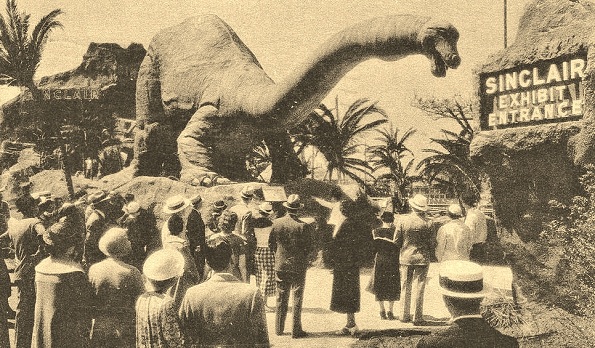
The first Sinclair “Brontosaurus” trademark made its debut in Chicago during the 1933 “Century of Progress” World’s Fair.
“Dino” and his prehistoric companions proved so popular that the company recreated its dinosaurs for the 1936 Texas Centennial Exposition and the 1939 New York World’s Fair. Refurbished, Sinclair Oil’s green giant returned to New York for another world’s fair in 1964-65 before touring shopping malls across America.
Learn more in Dinosaur Fever – Sinclair’s Icon.
May 28, 1923 – “Oil Well of the Century” taps Permian Basin
It took 646 days of difficult cable-tool drilling before a well near Big Lake, Texas, proved there was oil on University of Texas land in the Permian Basin. The arid region in Reagan County was once thought to be worthless, but the Santa Rita No. 1 well discovered an oilfield that helped reveal the Permian Basin’s vast petroleum potential.
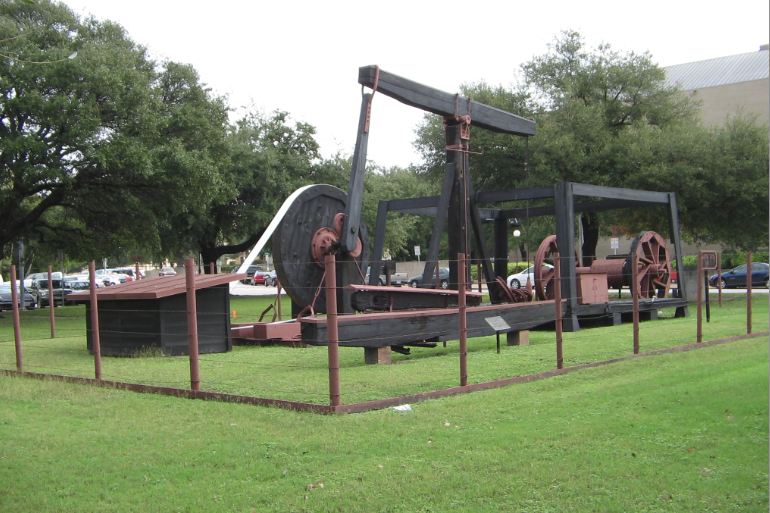
After almost two decades in storage, the Santa Rita No. 1 well’s walking beam and other equipment in 1958 was move to the University of Texas Austin campus and unveiled to the public.
Named for the patron saint of the impossible, the Santa Rita well produced oil for the next seven decades, and the University of Texas received $4 million in royalties within three years of the discovery by Texon Oil and Land Company. The student newspaper described the well “as one that made the difference between pine-shack classrooms and modern buildings.”
Texas Monthly in 1999 proclaimed Santa Rita No. 1, the “Oil Well of the Century.”
Learn more in Santa Rita taps Permian Basin.
May 29, 1940 – Nebraska’s First Oil Well
After more than a half-century of dry holes, Nebraska’s first commercial oil well was completed near Falls City in the southeastern corner of the state. Eager to join other states benefiting from tax revenue gained from petroleum, Nebraska lawmakers had offered a $15,000 bonus for the first well to produce 50 barrels of oil daily for two months.
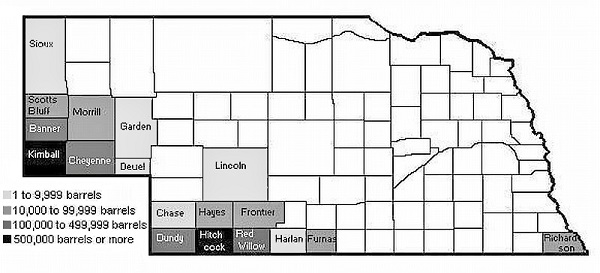
Although Nebraska oil production began in 1940 in Richardson County in the southeastern corner of the state, most production would come from western counties.
Pawnee Royalty Company completed the Bucholz No. 1 well with production of about 170 barrels of oil a day in its first 60 days. The bonus-winning well was about five miles east of a “vein of petroleum” first reported by geologists in 1883.
Learn more in First Nebraska Oil Well.
May 30, 1911 – First Indianapolis 500 takes Seven Hours
The first Indianapolis 500-mile race began with 40 cars; only 12 finished the 1911 test of endurance and automotive technology. The winner averaged almost 75 mph after about seven hours of racing.

All of the cars except the winner had a mechanic to manually pump oil. More than 60,000 watched the first race.
All cars except the winning No. 32 Marmon Wasp had two seats because drivers traveled with “riding mechanics,” who manually pumped oil. Ray Harroun, driver of the Marmon Wasp, later invented a kerosene carburetor. “Let the fuel people fight it out amongst themselves, I’ll have a car soon that will burn anything they send,” he declared.
A decade before Indy, gasoline powered less than 1,000 of 4,200 autos sold in America (see Cantankerous Combustion – 1st U.S. Auto Show).
May 30, 1987 – Million Barrel Museum opens in Monahans, Texas
The Million Barrel Museum opened on a 14.5-acre site in Monahans, Texas. The museum’s main attraction is a large elliptical oil storage tank built in 1928 to store Permian Basin oil.

The Monahans Million Barrel Museum’s 525-foot by 422-foot concrete foundation once included a wooden roof. The structure, built to store Permian Basin oil in 1928, became a Monahans water park for one day in 1958.
The experimental concrete tank — 525 feet by 422 feet — was designed to hold more than a million barrels of oil. The highly productive West Texas region lacked oil pipelines. The tank’s 30-foot earthen walls sloped at a 45-degree angle and were covered in concrete. It included a roof made of California redwood.
Repeated efforts could not stop oil from leaking at the seams. Shell eventually abandoned the giant structure, which would be patched to briefly become a water park in the 1950s…until it leaked again.
Learn more in Million Barrel Museum.
June 1, 1860 – First Book about Oil published
Less than 10 months after Edwin L. Drake completed the first commercial U.S. oil well at Titusville, Pennsylvania, Thomas A. Gale published an 80-page pamphlet many regard as the first book about America’s petroleum resources. The Wonder of the Nineteenth Century: Rock Oil in Pennsylvania and Elsewhere described the advantages of the new fuel source for kerosene lamps.
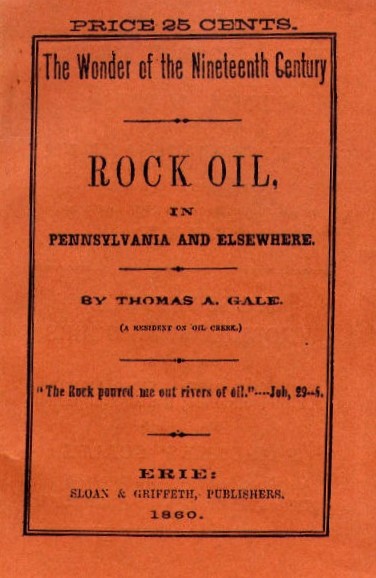
An 80-page pamphlet by Thomas Gale published in 1860 described the beginning of the petroleum age that began one year earlier at Titusville, Pennsylvania.
“Those who have not seen it burn, may rest assured its light is no moonshine; but something nearer the clear, strong, brilliant light of day,” Gale declared in his pamphlet, which sold for 25 cents. Only three original copies were known to exist in 1952, when Ethyl Corporation of New York republished The Wonder of the Nineteenth Century.
Learn more in First Oil Book of 1860.
June 1, 1899 – Giant California Oilfield discovered at Kern River
After others found signs of oil northeast of Bakersfield, California, Milton and Horace McWhorter drilled the region’s first commercial well. Their well revealed the 10,750-acre Kern River oilfield on the eastern edge of the southern San Joaquin Valley — the first of many contiguous fields to be found in Kern County.
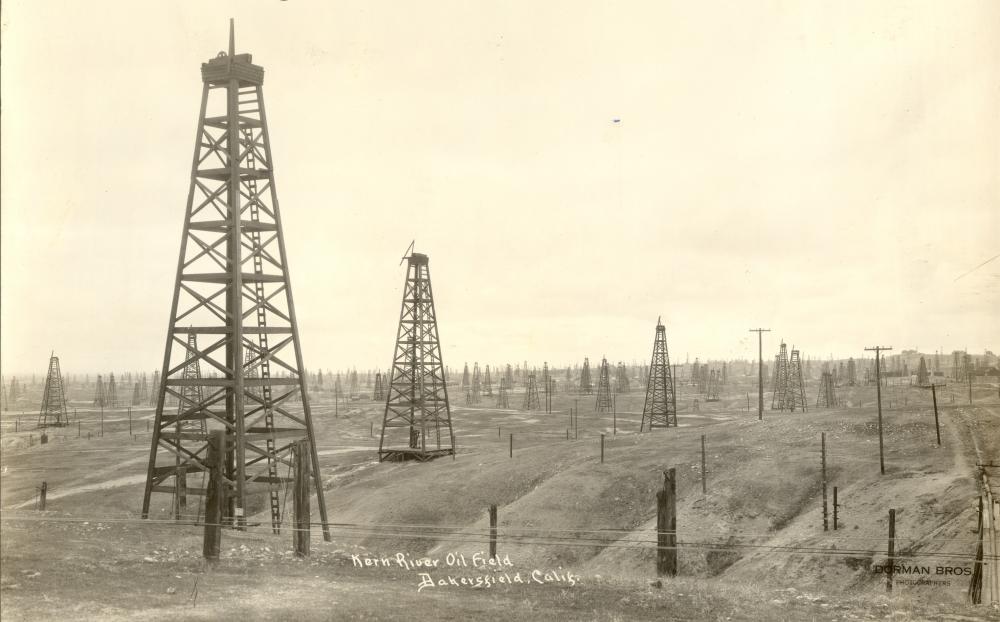
Discovered in 1899, California’s prolific Kern River field was the first of many giant Kern County oilfield discoveries. Circa 1910 photo courtesy Kern County Oil Museum.
A drilling boom expanded the state’s petroleum industry by attracting major oil companies (and briefly, retired lawman Wyatt Earp). Kern County’s annual oil production peaked in 1985 at 256 million barrels of oil. The 8,000-square-mile county accounted for 70 percent of California’s oil and more than 90 percent of its natural gas in 2020.
Learn more California oil history by visiting the West Kern Oil Museum and the Kern County Museum.
June 1, 1909 – Secret Test of Dual-Coned Drilling Bit
At Goose Creek near Galveston Bay, Texas, a drilling crew secretly tested a dual-cone roller bit. “In the early morning hours of June 1, 1909, Howard Hughes Sr. packed an experimental bit into the trunk of his car and drove off into the Texas plains,” noted Gwen Wright of the History Detectives. The coned roller bit would soon make traditional rotary fishtail bits obsolete.
“When the Hughes twin-cones hit hard rock, they kept turning, their dozens of sharp teeth (166 on each cone) grinding through the hard stone,” the PBS episode explained in 2006. Hughes and partner R. Carlton “Carl” Baker formed Baker Hughes Tools Company (see Carl Baker and Howard Hughes).
June 1, 1940 – Dallas Artist depicts Life in Texas Oilfields
Jerry Bywaters of Paris, Texas, exhibited his new oil painting Oil Field Girls at the Fine Arts Palace of San Francisco’s Golden Gate International Exposition. The 1940 painting of two young women in a West Texas oilfield and its companion piece, Oil Rig Workers (Roughnecks), would become among his best-known works.

Jerry Bywaters (1906-1989) painted Oil Field Girls and the Oil Rig Workers in 1940. The Blanton Museum of Art describes Bywaters’ Oil Field Girls as “a work of incredible moral complexity.”
Bywaters and Alexandre Hogue (see Oil Art of Graham, Texas) were members of the Dallas Nine, a group of young painters in the 1930s, “who helped establish a regional artistic identity for Texas art,” according to the Blanton Museum of Art at the University of Texas, Austin, which acquired Oil Field Girls in 1984. In 1981, Southern Methodist University established a Bywaters Special Collections. Bywaters died at 82 in Dallas in 1989.
_______________________
Recommended Reading: The Exciting World of Dinosaurs, Sinclair Dinoland, New York World’s Fair 1964-65 (souvenir booklet); Chronicles of an Oil Boom: Unlocking the Permian Basin (2014); Blood and Smoke: A True Tale of Mystery, Mayhem and the Birth of the Indy 500
(2012); The Wonder of the Nineteenth Century: Rock Oil in Pennsylvania and Elsewhere (1952); Black Gold in California: The Story of California Petroleum Industry (2016). Your Amazon purchase benefits the American Oil & Gas Historical Society. As an Amazon Associate, AOGHS earns a commission from qualifying purchases.
_______________________
The American Oil & Gas Historical Society (AOGHS) preserves U.S. petroleum history. Please become an AOGHS annual supporter and help maintain this energy education website and expand historical research. For more information, contact bawells@aoghs.org. Copyright © 2024 Bruce A. Wells. All rights reserved.



